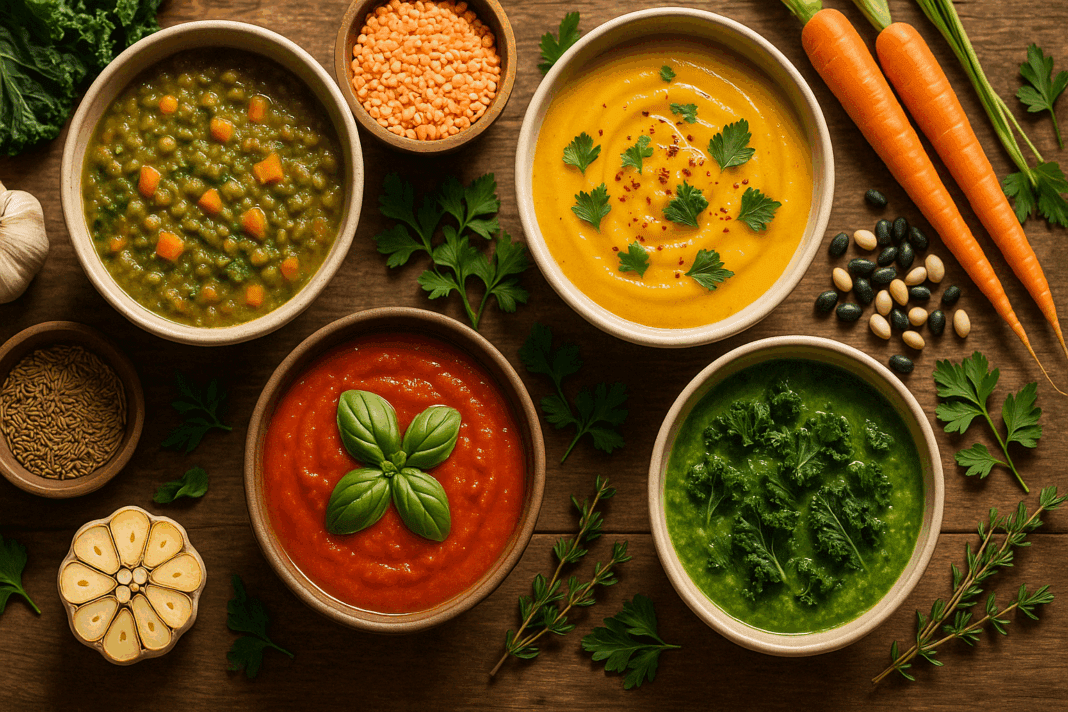The Growing Demand for Vegan and Gluten Free Soup Recipes
In recent years, the popularity of plant-based eating has surged, driven by growing awareness of its health, environmental, and ethical benefits. Simultaneously, the prevalence of gluten intolerance, celiac disease, and gluten sensitivity has led many individuals to seek gluten free alternatives in their diets. For those navigating both dietary paths, vegan and gluten free soup recipes offer an especially appealing option. These recipes provide comfort, nutrition, and convenience while avoiding animal products and gluten-containing ingredients. But beyond mere dietary restrictions, they also deliver a host of scientifically supported health benefits that make them worth embracing even for those without specific dietary limitations.
You may also like: Healthy Plant-Based Dinners Made Easy: Best Whole Food Plant-Based Recipes for Beginners and Beyond
Soups are one of the most versatile culinary formats, allowing for endless variation while maintaining simplicity. They can be nutrient-dense, fiber-rich, and packed with phytonutrients, making them excellent vehicles for whole-food, plant-based nutrition. Vegan and gluten free soup recipes not only cater to diverse palates and lifestyles, but also align with research-backed principles of chronic disease prevention and gut health enhancement. Many of these recipes highlight legumes, whole grains like quinoa, vegetables, and healing herbs and spices—ingredients frequently praised in nutritional science for their protective effects against conditions such as cardiovascular disease, type 2 diabetes, and inflammatory disorders.
Moreover, these soups are well-suited to batch cooking, making them ideal for meal prep and time-efficient nourishment. As plant-based diets continue to gain traction, the demand for sophisticated, health-supportive meals that also accommodate gluten free needs has never been higher. In the sections that follow, we explore ten expertly crafted vegan and gluten free soup recipes, each supported by the latest in nutritional research and designed to deliver both flavor and function.
Creamy Cauliflower and White Bean Soup: A Gut-Healing Powerhouse
This velvety soup combines the mild sweetness of cauliflower with the creamy texture of white beans, creating a dish that is both indulgent and nutritionally rich. Cauliflower is a cruciferous vegetable celebrated for its sulforaphane content—a sulfur-containing compound that supports detoxification and has been associated with reduced inflammation. When lightly steamed or simmered, cauliflower retains its potent phytochemicals while becoming easier to digest. White beans, on the other hand, are high in soluble fiber and resistant starch, both of which feed beneficial gut bacteria and help regulate blood sugar levels.
By blending these ingredients with aromatics like garlic and onion—both of which contain prebiotics that further nourish gut flora—this soup becomes a digestion-friendly staple. Olive oil, often added for richness, contributes monounsaturated fats that enhance the absorption of fat-soluble vitamins and support cardiovascular health. A small amount of nutritional yeast can be used to add depth and provide a source of B-complex vitamins, particularly B12 when fortified. Together, these ingredients create a soup that not only soothes the digestive tract but also contributes to a resilient microbiome, an increasingly recognized factor in overall health.
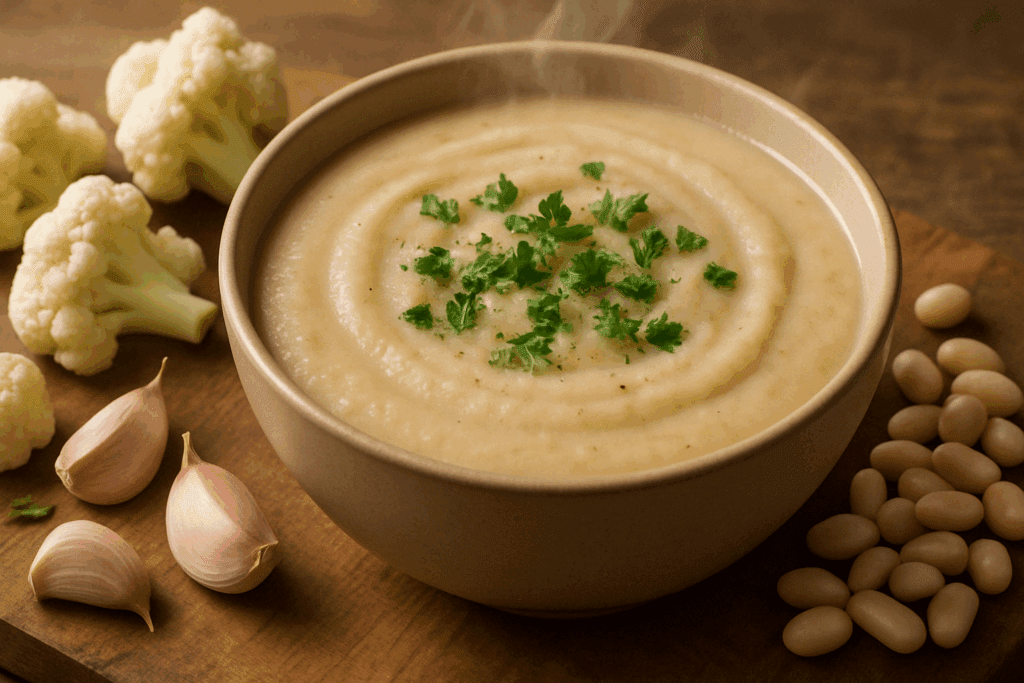
Red Lentil and Tomato Soup: Anti-Inflammatory and Protein-Rich
Red lentils are among the fastest-cooking legumes and boast a mild, nutty flavor that pairs beautifully with the bright acidity of tomatoes. This soup’s simplicity belies its nutritional complexity. Red lentils are a rich source of plant-based protein, iron, and folate—critical nutrients for energy metabolism and red blood cell formation. When combined with tomatoes, which are loaded with lycopene, a powerful antioxidant associated with reduced cancer risk and improved heart health, the resulting synergy amplifies the anti-inflammatory benefits.
Garlic, turmeric, cumin, and black pepper often accompany this dish, lending not only flavor but therapeutic value. Turmeric’s active compound, curcumin, has been extensively studied for its anti-inflammatory effects, particularly when combined with black pepper, which enhances its bioavailability. A drizzle of lemon juice at the end brightens the soup and adds vitamin C, further boosting iron absorption from the lentils. This soup is especially valuable for those following a vegan and gluten free diet, as it delivers a complete meal that is hearty, satiating, and aligned with anti-inflammatory dietary patterns.
Miso and Mushroom Soup with Quinoa: Umami Meets Amino Acids
Miso soup is a staple of traditional Japanese cuisine, often enjoyed for its umami-rich broth and probiotic properties. When reimagined in a vegan and gluten free context, this classic becomes a nourishing elixir. Miso made from fermented chickpeas or gluten free rice is a safe alternative to traditional barley-based versions for those avoiding gluten. It introduces beneficial bacteria that support gut flora, though it’s important to avoid boiling miso to preserve its probiotic integrity.
Pairing miso with mushrooms—especially shiitake or maitake—adds depth of flavor and medicinal benefits. These fungi are known for their beta-glucan content, which has been linked to immune modulation and anti-cancer effects in numerous studies. Quinoa, a naturally gluten free pseudograin, complements the soup with complete protein and magnesium, aiding in muscle function and energy production. A touch of seaweed, such as wakame, contributes iodine for thyroid support, while scallions and sesame oil elevate the flavor profile without compromising the soup’s clean, plant-based foundation. This soup serves as a perfect example of how vegan and gluten free soup recipes can blend tradition with nutritional sophistication.
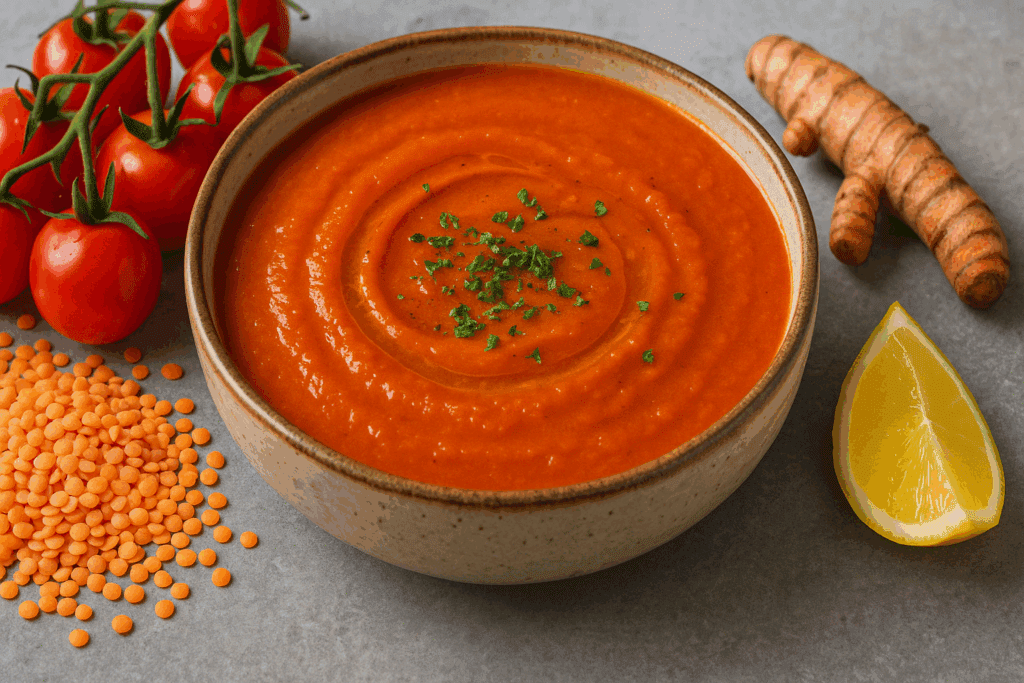
Spiced Carrot and Ginger Soup: A Zesty Boost for Immunity
Carrots are a well-known source of beta-carotene, the precursor to vitamin A, which is essential for immune function, vision, and skin health. In this vibrant soup, the sweetness of carrots is offset by the warming heat of ginger, creating a balance of flavors that also supports respiratory health and digestion. Ginger has long been used in both culinary and medicinal traditions for its anti-inflammatory and anti-nausea properties, backed by a wealth of clinical studies.
Adding coconut milk or a cashew cream base gives this soup its characteristic silkiness without relying on dairy. These plant-based fats not only provide a creamy texture but also help with the absorption of fat-soluble vitamins. Turmeric and black pepper often make appearances in this soup as well, enhancing its anti-inflammatory properties. When paired with a whole-food source of carbohydrates like sweet potato or a side of gluten free bread, this soup transforms into a nourishing meal with balanced macronutrients and immune-supportive ingredients. It’s no surprise that this recipe has become a go-to for cold and flu season in many health-conscious households.
Butternut Squash and Apple Soup: A Sweet and Savory Fall Classic
This autumnal favorite brings together the comforting sweetness of roasted butternut squash with the tartness of apples, resulting in a soup that is as pleasing to the palate as it is nourishing to the body. Butternut squash is high in vitamins A and C, both of which play crucial roles in immune function and collagen synthesis. Apples add not only a pleasant acidity but also pectin, a soluble fiber that promotes digestive health and regulates blood sugar levels.
Roasting the squash before pureeing enhances its natural sweetness and caramelization, while also preserving its antioxidant content. Onions and garlic build the flavor base, and a splash of apple cider vinegar at the end can brighten the soup and aid in digestion. The addition of warming spices like cinnamon, nutmeg, or clove lends seasonal depth and may help regulate blood sugar through their insulin-sensitizing properties. Finished with a swirl of cashew cream or a sprinkle of toasted pumpkin seeds, this soup exemplifies how vegan and gluten free soup recipes can marry flavor, tradition, and science into a comforting bowl.
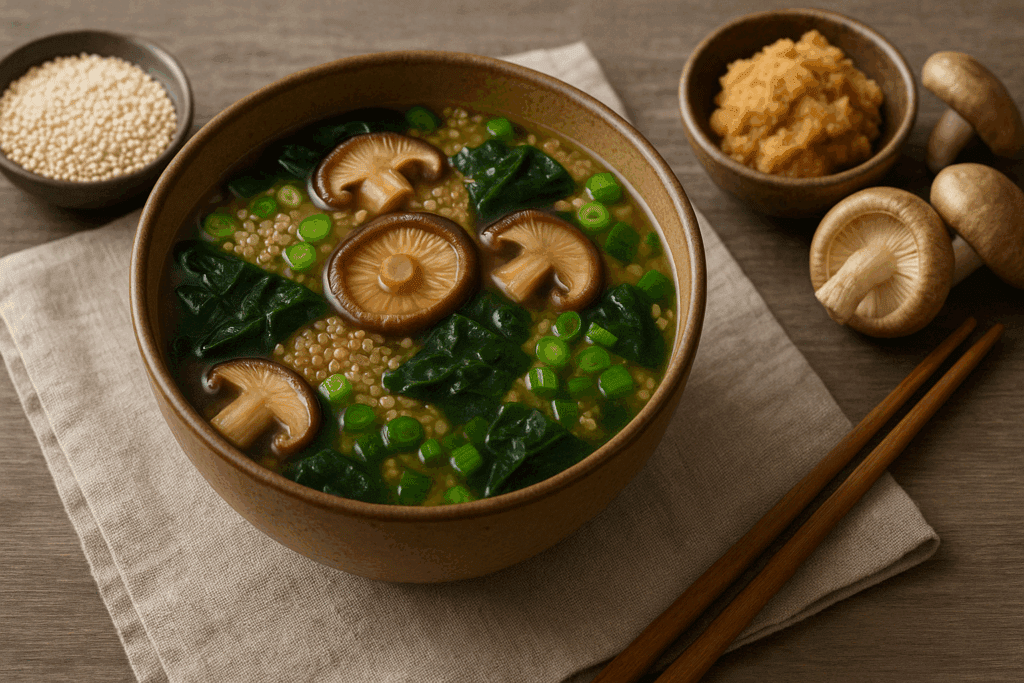
Hearty Black Bean and Sweet Potato Soup: Fiber-Fueled and Blood Sugar-Friendly
Black beans are a staple in many traditional cuisines and an excellent source of plant-based protein, iron, and fiber. When combined with sweet potatoes—rich in complex carbohydrates, beta-carotene, and potassium—the result is a soup that stabilizes blood sugar and supports cardiovascular health. The combination of fiber from both the beans and sweet potatoes promotes satiety, reduces LDL cholesterol, and nourishes the gut microbiota.
This soup often features cumin, paprika, and a hint of lime, adding depth of flavor and digestive support. Tomatoes or tomato paste contribute additional antioxidants, while cilantro and avocado may be used as toppings to enhance nutrient density. Black beans contain resistant starch, which has been linked to improved insulin sensitivity and weight management. When made in advance, the resistant starch content actually increases, making leftovers even more metabolically beneficial. This recipe is a prime example of how vegan and gluten free soup options can deliver complex flavors while promoting metabolic health.

Zucchini and Basil Soup with Cannellini Beans: Light, Refreshing, and Detox-Friendly
For a lighter option, this green-hued soup offers a refreshing blend of zucchini and basil with creamy cannellini beans. Zucchini is a low-calorie vegetable high in water and vitamin C, making it ideal for hydration and skin support. Cannellini beans add fiber, protein, and iron, creating a balanced soup that can be enjoyed year-round. Fresh basil, beyond its aromatic appeal, contains volatile compounds like eugenol, which may possess anti-inflammatory and antimicrobial properties.
Blending these ingredients yields a creamy yet delicate texture, often enhanced by a small amount of extra virgin olive oil for richness. A squeeze of lemon juice provides brightness and increases the bioavailability of plant-based iron. This soup can be served warm or chilled, making it a versatile addition to any meal plan. Its light profile makes it especially suitable for spring detox protocols or as a starter to a more substantial meal, proving that vegan and gluten free soup recipes can be both gentle and invigorating.
Thai-Inspired Coconut Curry Soup with Tofu: Global Flavors, Balanced Nutrition
Drawing inspiration from Southeast Asian cuisine, this coconut curry soup features bold flavors and nutrient-dense ingredients. Coconut milk provides a rich base that is both dairy-free and high in medium-chain triglycerides (MCTs), which may support cognitive health and energy metabolism. Red curry paste, lemongrass, and lime infuse the soup with complexity, while tofu serves as a protein-rich addition that makes the dish satisfying and complete.
Vegetables like bell peppers, snap peas, and mushrooms contribute a range of vitamins, minerals, and antioxidants. The use of tamari (a gluten free soy sauce alternative) ensures the dish remains gluten free without sacrificing umami. Tofu, made from soybeans, offers complete protein and isoflavones—plant compounds linked to hormonal balance and cardiovascular benefits. Served with a scoop of brown rice or rice noodles, this soup demonstrates how vegan and gluten free soup recipes can accommodate global culinary traditions while delivering robust nutrition.
Green Pea and Mint Soup: A Springtime Revival with Anti-Aging Benefits
Green peas are often underestimated, but they are a nutritional powerhouse. High in protein, fiber, and phytonutrients, peas support muscle maintenance, blood sugar balance, and cellular repair. This soup combines the natural sweetness of green peas with the invigorating coolness of mint, creating a rejuvenating dish ideal for spring. The chlorophyll and polyphenols in peas may help combat oxidative stress, supporting skin health and longevity.
Mint, beyond its refreshing flavor, has been studied for its digestive benefits and potential to reduce symptoms of irritable bowel syndrome (IBS). Blended with a touch of almond or oat milk, the soup achieves a creamy texture without dairy. A garnish of lemon zest or vegan yogurt adds brightness and probiotic support. This elegant yet simple soup underscores how even the most humble ingredients can be elevated into gourmet vegan and gluten free soup recipes with powerful health benefits.
Broccoli and Kale Detox Soup: Cruciferous Cleansing with Immune Support
Few ingredients are as synonymous with detoxification as broccoli and kale, both members of the cruciferous vegetable family. These greens are rich in glucosinolates, which convert into biologically active compounds that support liver detoxification pathways. When simmered gently in a vegetable broth with garlic, onion, and celery, they create a soup that is both fortifying and cleansing.
Adding a handful of parsley boosts chlorophyll content and provides vitamin K, essential for bone health and blood clotting. Blended with white beans or silken tofu, the soup gains creaminess and protein without relying on dairy or gluten-containing thickeners. A splash of lemon or apple cider vinegar enlivens the flavor and enhances nutrient absorption. This detox soup illustrates the best of what vegan and gluten free soup recipes have to offer—whole-food ingredients that nurture the body at a cellular level.
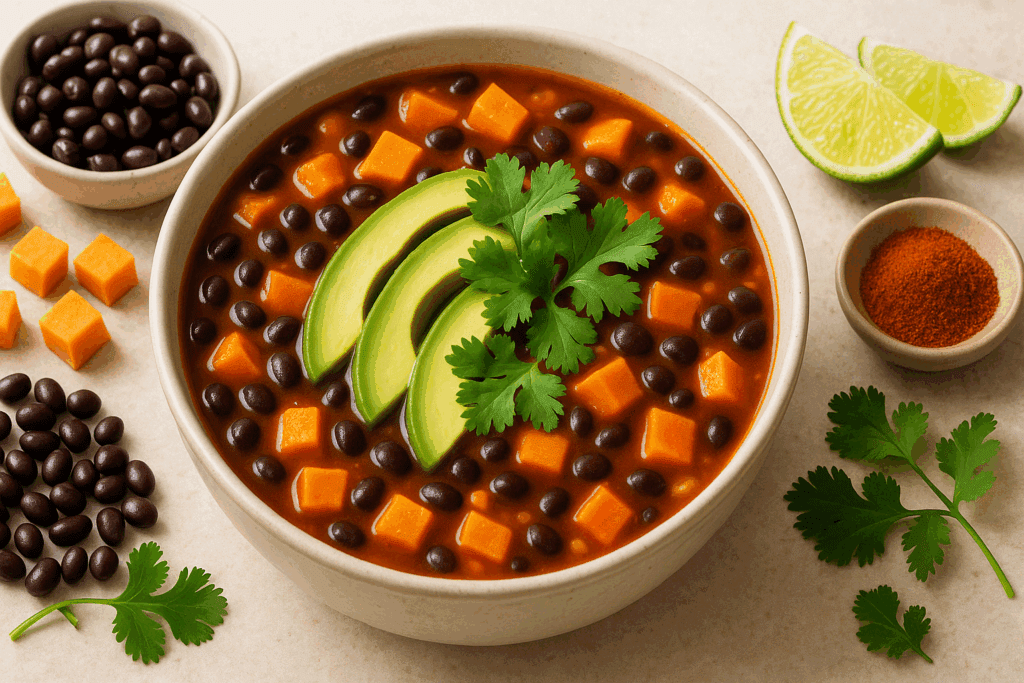
Frequently Asked Questions: Vegan and Gluten Free Soup Recipes
1. What are some advanced techniques to enhance the flavor of vegan and gluten free soup recipes without relying on animal products or gluten-based thickeners?
To elevate the depth of flavor in vegan and gluten free soup recipes, home cooks can embrace techniques like umami layering and dry roasting spices. Caramelizing onions and garlic slowly can create a savory base, while adding ingredients such as nutritional yeast, miso paste (gluten free varieties), sun-dried tomatoes, or dried mushrooms enhances umami naturally. Roasting vegetables before simmering them in broth brings out natural sugars and intensifies flavor complexity. Additionally, using pureed legumes like red lentils or white beans can thicken soups effectively without flour or cream. These strategies ensure that even the simplest vegan and gluten free soup tastes robust, satisfying, and multidimensional.
2. Can vegan and gluten free soup recipes support long-term gut health and microbiome diversity?
Yes, when carefully designed, vegan and gluten free soup recipes can be powerful allies in supporting gut health and microbial diversity. Legumes, which feature prominently in many such soups, are rich in both soluble and insoluble fiber, feeding beneficial gut bacteria and promoting regular bowel movements. Fermented additions like kimchi brine or chickpea miso (added after cooking) introduce live probiotics that can further enhance microbiota composition. Soups built on whole vegetables and herbs—such as garlic, leeks, and Jerusalem artichokes—naturally include prebiotics that support probiotic colonization. For individuals transitioning to a plant-based or gluten free lifestyle, soups can provide a gentle, healing base that helps the digestive system adapt. Over time, consistent intake of these ingredients through vegan and gluten free soup helps build resilience within the gut ecosystem.
3. How can I create vegan and gluten free soup recipes that support athletic performance and recovery?
Athletes often overlook the restorative power of soup, yet vegan and gluten free soup can be a strategic part of post-workout nutrition. To support muscle repair and energy replenishment, soups can be enriched with quinoa, tofu, lentils, or tempeh—complete or near-complete plant protein sources. Including anti-inflammatory herbs and spices like turmeric, ginger, and garlic aids in recovery by modulating oxidative stress. Hydration is another key benefit; soups contribute fluid and electrolytes lost during intense training. Adding potassium-rich vegetables such as spinach, sweet potatoes, or zucchini can restore electrolyte balance. When timed well—such as a hearty miso-quinoa soup within an hour of exercise—vegan and gluten free soup recipes can offer a strategic advantage for both endurance and strength-focused athletes.
4. Are there any overlooked ingredients that can boost the nutritional density of vegan and gluten free soup?
Absolutely. While many recipes rely on standard vegetables and legumes, incorporating lesser-used superfoods can dramatically elevate the nutrient profile of a vegan and gluten free soup. Sea vegetables like dulse or wakame introduce iodine, magnesium, and trace minerals crucial for thyroid and metabolic function. Microgreens or sprouts added just before serving provide living enzymes and vitamin C, boosting immune defenses. Adding a spoonful of ground flaxseed delivers omega-3s and lignans, compounds that support hormonal balance. Even small additions like blackstrap molasses (for iron and calcium) or pureed pumpkin seeds (for zinc and protein) can turn an everyday soup into a concentrated health tonic. These additions showcase how strategic ingredient choices can transform the nutritional impact of vegan and gluten free soup recipes.
5. How can vegan and gluten free soup recipes help manage blood sugar and support metabolic health?
Vegan and gluten free soup is uniquely positioned to support stable blood sugar due to its high fiber and low glycemic load when properly constructed. Using whole legumes like black beans or chickpeas instead of processed carbohydrates helps slow glucose absorption and reduces insulin spikes. Incorporating resistant starches—found in cooled sweet potatoes or cooked-and-chilled lentils—enhances insulin sensitivity and feeds beneficial gut microbes. Cinnamon, fenugreek, and apple cider vinegar, when added in small amounts, may improve glucose metabolism based on emerging evidence. Avoiding thickeners like cornstarch or wheat flour in favor of pureed root vegetables ensures that texture doesn’t come at the cost of glycemic integrity. Regular consumption of balanced vegan and gluten free soup recipes can play a subtle yet meaningful role in long-term blood sugar regulation.
6. How can busy professionals integrate vegan and gluten free soup into their weekly routine without compromising variety?
For time-constrained individuals, vegan and gluten free soup offers a meal prep solution that is both efficient and diverse. Batch cooking one or two large pots of base soup on the weekend—such as lentil-vegetable or creamy cauliflower-bean—allows for mid-week adaptations. Each day, portions can be customized by adding fresh herbs, steamed greens, or grain toppings like millet or brown rice. Freezing half of the batch in individual portions ensures variety across multiple weeks. Pressure cookers and slow cookers make hands-free preparation easier, especially for tougher legumes or root vegetables. With a few rotating seasonal ingredients and modular spice blends, busy professionals can enjoy multiple distinct vegan and gluten free soup recipes throughout the week without repeating flavors.
7. Are there cultural or global traditions that inspire unique vegan and gluten free soup recipes?
Indeed, many traditional cuisines naturally align with the principles of vegan and gluten free soup, offering a wealth of global inspiration. Indian dal, Thai tom kha (with coconut milk and lemongrass), and Ethiopian shiro wat (a spiced legume stew) are naturally gluten free and plant-based when prepared without ghee or wheat flour. Middle Eastern lentil soups often include warming spices like cumin and sumac, while South American quinoa soups highlight native grains and tubers. These culinary traditions not only diversify the flavor profile of vegan and gluten free soup recipes but also introduce time-tested combinations of spices and vegetables that have supported wellness for generations. Exploring these traditions invites a deeper appreciation for cultural wisdom embedded in everyday meals.
8. What is the role of texture in creating satisfying vegan and gluten free soup recipes?
Texture plays a critical role in enhancing satiety and sensory enjoyment, particularly in vegan and gluten free soup recipes where cream and meat textures are absent. Incorporating contrasting textures—like pureed bases with added crunchy toppings—can heighten satisfaction. For example, blending carrots and lentils into a creamy soup and topping it with toasted seeds or gluten free croutons creates a multi-layered experience. Using spiralized vegetables, roasted chickpeas, or chewy grains like wild rice adds further textural interest. Even a light swirl of tahini or a spoonful of fermented kraut can break monotony and contribute to mouthfeel diversity. Recognizing and balancing textures is an underutilized yet powerful strategy in crafting memorable vegan and gluten free soup.
9. How might vegan and gluten free soup support emotional well-being or mindful eating practices?
Soup, by its very nature, encourages slow consumption, warmth, and grounding—all of which support mindful eating and emotional well-being. Vegan and gluten free soup can act as a calming ritual, especially when made from scratch using whole ingredients that engage the senses during preparation. The aroma of simmering herbs, the vibrant colors of vegetables, and the act of stirring can anchor attention in the present moment. For those navigating dietary restrictions, soup can also provide emotional reassurance—offering a safe, nourishing space free of inflammatory triggers. Creating or sharing these recipes with others can foster connection, turning a simple meal into an act of community and care. Thus, beyond nutrition, vegan and gluten free soup contributes to emotional nourishment and culinary mindfulness.
10. What future innovations might shape the next generation of vegan and gluten free soup recipes?
Emerging food technologies and sustainability trends are poised to transform how we approach vegan and gluten free soup recipes. Advances in precision fermentation may soon make nutrient-rich broths using fermented fungi or microalgae more accessible and sustainable. AI-driven recipe platforms are helping users generate personalized soup recipes based on nutritional needs, allergies, and microbiome data. Ingredient innovations, such as lentil-based pastas or sprouted legume powders, could offer new ways to thicken and enrich soups without compromising digestibility. Additionally, upcycled vegetable byproducts, like carrot pulp or cauliflower leaves, are being repurposed into gourmet soup bases in eco-conscious kitchens. These developments promise a future where vegan and gluten free soup is not only more accessible and customized but also more ecologically aligned and technologically enhanced.
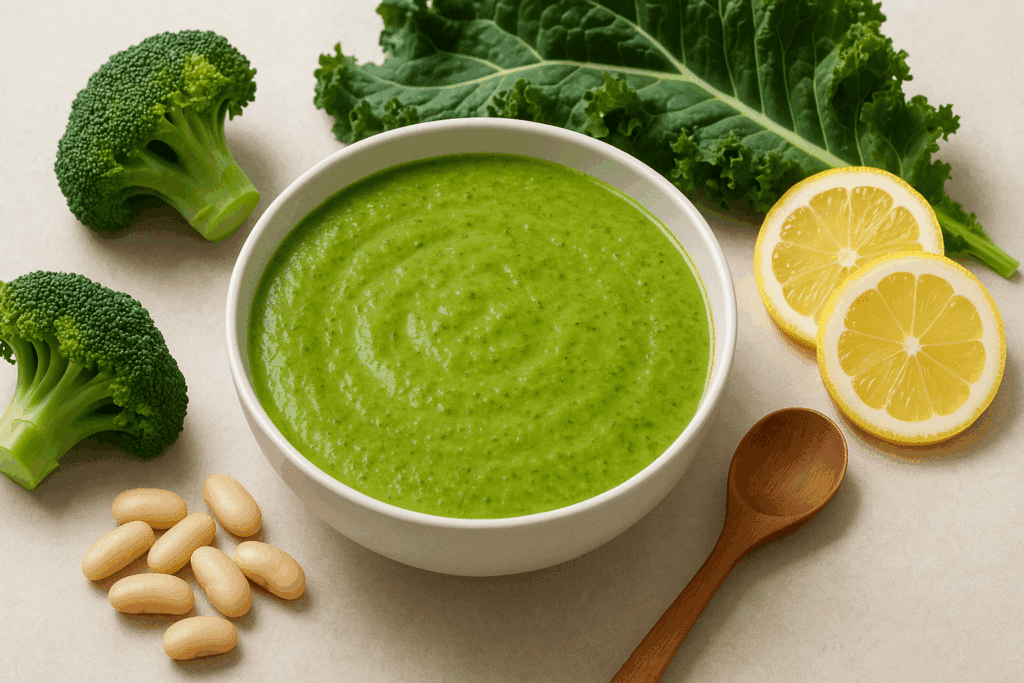
Conclusion: Embracing the Healing Power of Vegan and Gluten Free Soup Recipes
As dietary awareness continues to evolve, the appeal of vegan and gluten free soup recipes grows stronger—not just as a response to health needs, but as a proactive approach to lifelong wellness. Each soup described above reflects a harmonious blend of culinary tradition, modern nutrition science, and practical application. These soups showcase the richness of whole-food, plant-based ingredients and their ability to deliver not only exquisite flavor but also profound health benefits.
Whether supporting digestive health through resistant starches and prebiotics, bolstering immunity with antioxidants and phytochemicals, or promoting metabolic balance through fiber and plant-based proteins, these soups transcend their humble origins. They are accessible, adaptable, and deeply nourishing, offering something for every palate and nutritional need. As we increasingly recognize the role of food as medicine, integrating vegan and gluten free soup recipes into our routine becomes a delicious and empowering choice.
Ultimately, these soups are more than meals—they are daily rituals of care, acts of nourishment that align with both individual health goals and a broader vision of sustainable living. Through thoughtful ingredients and intentional preparation, each bowl invites us to slow down, savor, and reconnect with the healing potential of whole, plant-based foods. In doing so, we nourish not only our bodies but also our sense of purpose, vitality, and connection to the world around us.

